With the Inflation Reduction Act, Congress Takes a Monumental Step in the Climate Fight
Here’s what it took to pass this climate bill and how it could change the game for climate action.
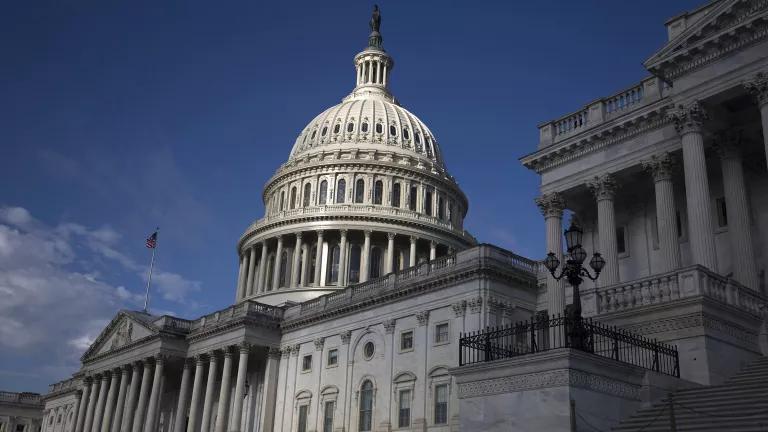
The Capitol building in Washington, D.C.
Sarah Baker
It’s a turning point many climate advocates weren’t sure they would ever see.
For years, and with little luck, Congress had tried to find common ground on the kind of transformative climate legislation this country needed. It was only in the eleventh hour that compromise found a way, and the Inflation Reduction Act of 2022 (IRA)—a sweeping climate and health care package that invests $369 billion in energy, climate, and justice over 10 years—was signed into law.
Now the bill promises to spur an unprecedented renewable energy boom, create hundreds of thousands of clean energy jobs, and help the United States curb greenhouse gas emissions up to 40 percent, below 2005 levels, by 2030.
“It’s the most historic and significant investment toward tackling climate change that we’ve ever seen come out of Congress,” says Alexandra Adams, senior director of NRDC’s Federal Affairs team. And it nearly didn’t happen.
The fight to get a bill over the finish line was long and came down to the wire. It was a collective effort led by a diverse group of climate, environmental justice, and labor advocates, including dozens of NRDC experts and policy advocates, all weighing in and pressing for critical investments. It was also supported by NRDC’s three million members and online activists, who demanded through petitions, calls, rallies, and town halls that our government take bold action. Now the new law is poised to change the game for U.S. climate action, as well as the trajectory of the climate crisis itself.
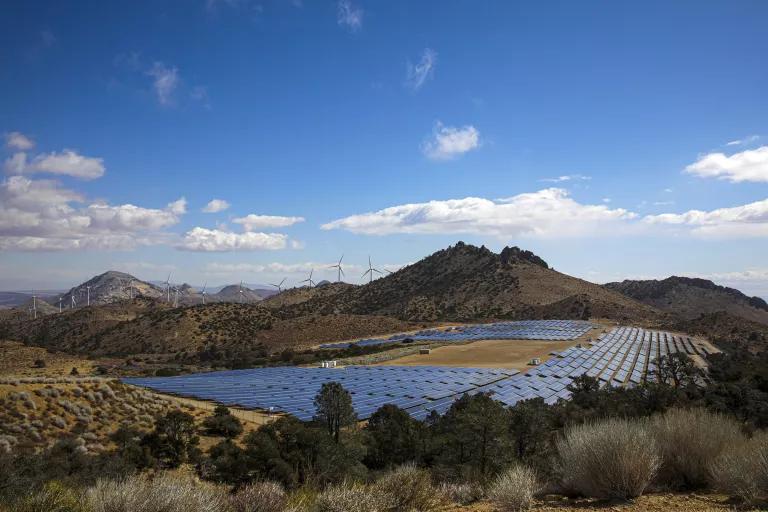
The Pine Tree wind farm and solar power plant in the Tehachapi Mountains, Kern County, California
Irfan Khan / Los Angeles Times via Getty Images
The long return to legislation
Prior to the introduction of this bill, it’d been more than a decade since robust climate legislation had a real shot at passing in Congress.
Back in 2009, NRDC worked to pass the American Clean Energy and Security Act, an emissions trading bill better known as Waxman-Markey. It made it through the House, but the threat of a filibuster kept it off the Senate floor—a loss that stalled the climate movement and ultimately forced NRDC’s climate strategy to pivot away from federal legislation.
Instead, NRDC doubled down on its regulatory efforts. “We worked really hard on the Clean Power Plan for several years, only to later see that scuttled by the courts,” says Jamie Consuegra, NRDC’s director of Congressional & External Affairs. Then came a slew of regulatory rollbacks by the Trump administration and, most recently, the West Virginia v. EPA U.S. Supreme Court decision that further curtailed the authority of federal agencies.
“I think we’ve learned that regulations alone won’t get us to where we need to go,” Consuegra says. “It has continued to be true that legislation is much more durable.”
That’s why the stakes of the 2020 election felt higher than ever. But soon after Election Day, the situation remained unclear. Democrats had won the White House and retained control of the House, but Republicans took the lead in the Senate. Then, in January, two Senate runoff races in Georgia resulted in victories for the Democrats. Suddenly, there was a realistic shot of getting 50 pro-climate votes in the Senate—enough to secure a majority when you count the tie-breaking vote of Vice President Kamala Harris. “That totally changed the game,” Consuegra says.
This coincided with a climate crisis that was becoming more visible to all. While the evidence had been clear for decades, few could now deny the increasingly severe wildfires, heat waves, floods, and droughts outside their own front doors.
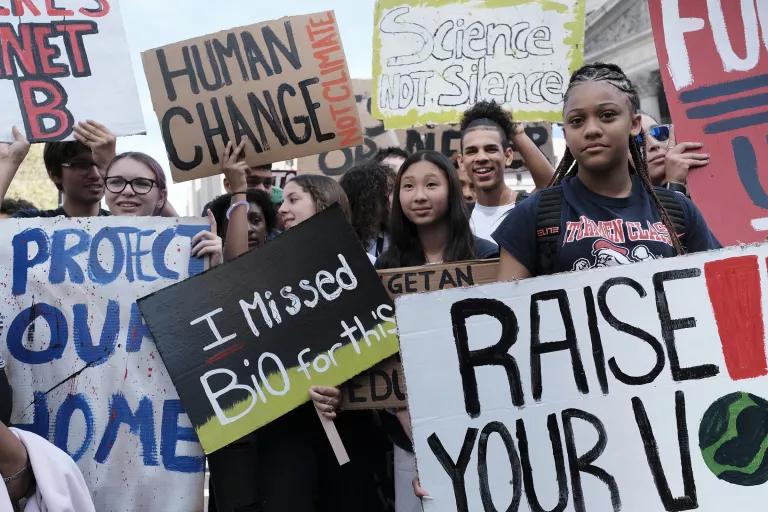
Young protesters outside the New York County Supreme Court building during a 2019 climate strike in New York City
Rick Gershon for NRDC
A chorus of voices come together for climate action
By the time the new class of legislators took office in 2021, climate advocates knew it was their moment. Perhaps one of their last.
Thanks in part to a growing youth climate movement, the climate crisis was front and center in the administration’s Build Back Better agenda, which set a bold new emissions target—cutting U.S. greenhouse gas emissions in half by 2030, when compared to 2005 levels, and hitting net-zero emissions by 2050. “Both chambers began immediately working on draft legislation,” Adams says, “and it was guided by this Build Back Better agenda.”
It was critical, though, to write a different kind of climate legislation than in the past—one that connected the dots between the climate, the economy, and inequity. And for that, a lot of diverse voices needed to be heard.
From the start, NRDC worked hand in hand with dozens of climate, labor, and environmental justice groups and as a member of multiple coalitions—including the Climate Action Campaign, the BlueGreen Alliance, and the Equitable & Just National Climate Platform. Together, they brought more unified political muscle than ever before, which allowed them to push harder for provisions that would reduce emissions while still protecting workers, investing in frontline communities, and putting money back into the pockets of consumers.
NRDC also relied on all the other tools in its advocacy toolbox.
NRDC and the NRDC Action Fund published op-eds, talked with reporters, and ran ads in key districts to get the word out about the most pressing issues in the Build Back Better agenda. Tens of thousands of NRDC members reached out to their representatives directly, urging them to pass strong climate legislation. And in Washington, NRDC staff kept in close contact with congressional committee members as legislative language was shaped and reshaped. Other staffers did the same with companies and industry associations to adjust and improve elements of the bill and win over support, particularly in the clean energy and electric vehicle sectors, which were essential to getting holdouts to vote for the bill. “Every kind of outreach you can do, we were doing,” Adams says.
NRDC’s Science Office and its Climate & Clean Energy team also helped crunch the numbers on expected job growth from the Build Back Better agenda in key states. “When looking at a package as expansive as this, you really need an organization like ours to help do that work,” Consuegra says. “NRDC is a trusted voice when it comes to being honest about what a bill can do.”
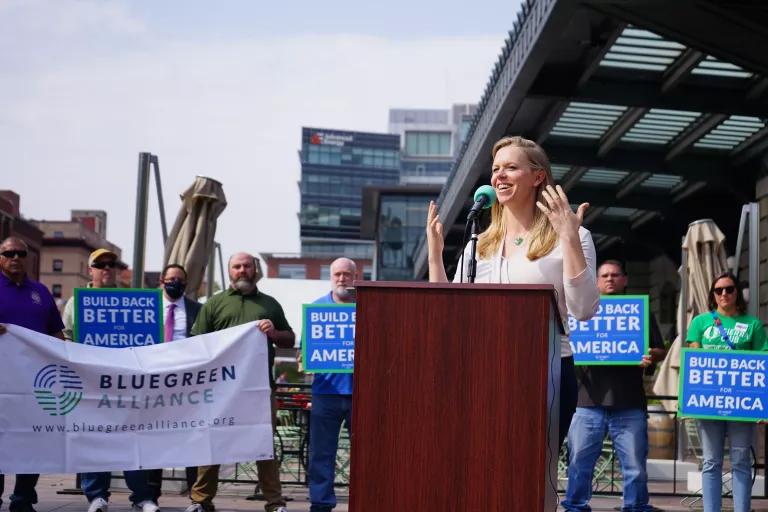
Kayla Calkin, political director of NRDC Action Fund, speaking during a BlueGreen Alliance–NRDC Action Fund press event at Union Station, Denver
Courtesy Progress Now Colorado (PNC)
The unlikely road to a final deal
But even with an all-out lobbying push, getting these necessary climate investments took more than one go.
In the second half of 2021, Congress was able to pass the $1.2 trillion Infrastructure Investment and Jobs Act, which scored significant wins on issues like public transit and clean drinking water. But it wasn’t the climate-first bill that was needed.
The centerpiece of the climate strategy would be the Build Back Better Act, which advocates hoped could pass through a process called budget reconciliation that requires only a 51-vote majority, rather than the 60 votes most legislation needs to overcome a filibuster. When the House passed a $3.5 trillion version of this reconciliation bill in the fall of 2021, the Senate was expected to tweak it, but still move forward.
Instead, just before Christmas, West Virginia Senator Joe Manchin announced that he wouldn’t back the accompanying Senate bill as written. “At first, we thought it was over, but it was obvious there was room to negotiate,” Adams says. “People were still wanting to get this done.”
Conversations and compromises continued into the new year, and a deal again appeared within arm’s reach by summer of 2022. That is, until yet another announcement from Senator Manchin stalled the bill. The chance to pass ambitious climate legislation and reach our most pressing climate goals took a serious blow.
“This was the main boulder we’d been trying to push up the hill for the past few years,” says Aparna Kumar, who works as an assistant director of communications for the Service Employees International Union and is a member of the BlueGreen Alliance and an early supporter of the bill. “We were holding our breath, but we never threw in the towel.”
The years of building new alliances and tirelessly advocating in support of climate legislation ended up paying off. In the eleventh hour, Senate majority leader Chuck Schumer announced that negotiations had turned a corner during closed-door deliberations. A deal, called the Inflation Reduction Act of 2022, which focused heavily on clean energy incentives and their economic benefits, had been reached.
“This was too important to let die,” Adams says. “The Senate majority took up the mantle, knew they had to deal with climate, and then did it.” Within weeks of its unveiling, the bill passed through the Senate, sailed through the House, and landed on President Joe Biden’s desk for his signature.

Alex Adams, senior director of Federal Affairs at NRDC
Courtesy of Alex Adams
A climate bill makes history
The bill, which stayed largely intact, will go down as the most significant investment in climate in U.S. history.
Plus, the costs are all more than covered by reforming the way the federal government pays for prescription drugs, enhancing Internal Revenue Service collections, and ensuring that profitable corporations pay their fair share of taxes.
As a result, it offers tens of billions in tax credits and incentives to rapidly expand the country’s renewable energy production, helps make electric vehicles more affordable, cleans up high-polluting industries like cement and steel production, and overhauls building emissions, among dozens of other climate provisions. “Not only will this legislation go a long way toward reducing our emissions but it also ensures that the workers who will build these critical infrastructure projects are paid family-sustaining wages,” says James Williams Jr., general president of the International Union of Painters and Allied Trades, a BlueGreen Alliance partner.
In addition, the act directs $60 billion in clean energy investments to low-income communities and people of color, for projects like improving energy efficiency in affordable housing, increasing air pollution monitoring, and buying low-emission school buses and trucks. That said, climate advocates are clear the bill was not the one they would have written, as it continues to prop up polluting industries, like oil and gas, that will most directly impact these same frontline communities.
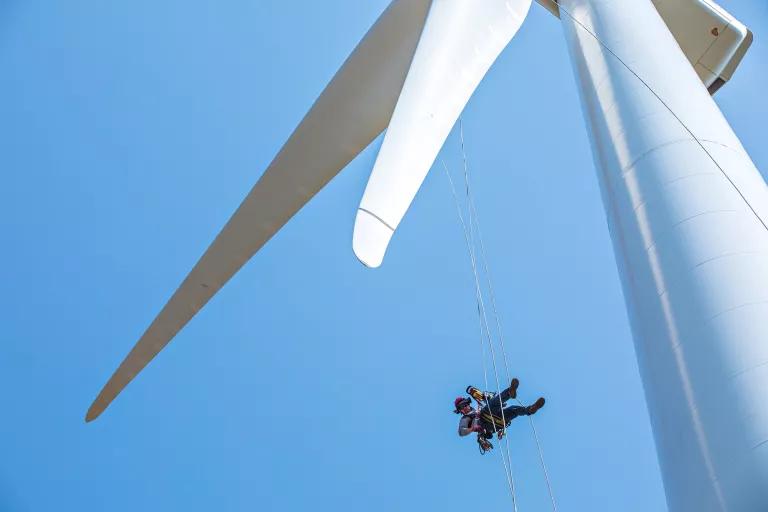
A worker performing a final check of the end of a wind turbine blade at the Foothills Campus of the National Renewable Energy Laboratory, just south of Boulder, Colorado
Werner Slocum/NREL, 65543
What comes next
Overall, the Inflation Reduction Act marks a major step forward, but it’s only the first step. “We don’t get to call it a day and go home now,” Adams says.
Implementation is on the horizon. Federal agencies must now take the baton and publish strong rules that finish closing the gap on the country’s emissions reduction goal. “The bill’s investments are going to make it that much easier to comply with future regulations,” Consuegra says. “This will help us reduce emissions faster too.”
Advocates also know that they must continue to fight provisions that harm our environment and predominantly affect communities already overburdened by pollution. This includes measures like the increased oil and gas projects in the Mountain West, Appalachia, the Gulf South, and the Arctic. NRDC will push back in partnership with others by pursuing more legislation, federal standards, and litigation where necessary.
For today, there is cause for some celebration. “This kind of action on climate always felt just enough out of reach so as to make you question whether we could ever get it done,” Adams says. “Today, that question feels answered for me. It’s giving me hope about what kind of future we can look forward to.”
This NRDC.org story is available for online republication by news media outlets or nonprofits under these conditions: The writer(s) must be credited with a byline; you must note prominently that the story was originally published by NRDC.org and link to the original; the story cannot be edited (beyond simple things such as grammar); you can’t resell the story in any form or grant republishing rights to other outlets; you can’t republish our material wholesale or automatically—you need to select stories individually; you can’t republish the photos or graphics on our site without specific permission; you should drop us a note to let us know when you’ve used one of our stories.

How You Can Stop Global Warming
A Consumer Guide to the Inflation Reduction Act
How to Ditch the Biggest Fossil Fuel Offenders in Your Life
How You Can Stop Global Warming
A Consumer Guide to the Inflation Reduction Act
How to Ditch the Biggest Fossil Fuel Offenders in Your Life
How You Can Stop Global Warming
A Consumer Guide to the Inflation Reduction Act
How to Ditch the Biggest Fossil Fuel Offenders in Your Life
How You Can Stop Global Warming
A Consumer Guide to the Inflation Reduction Act